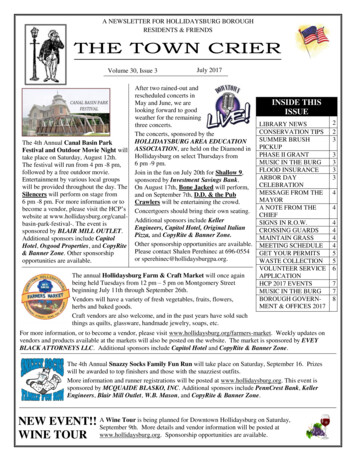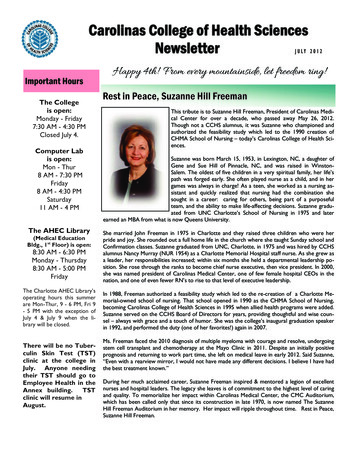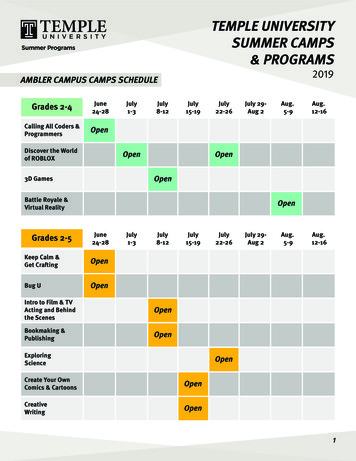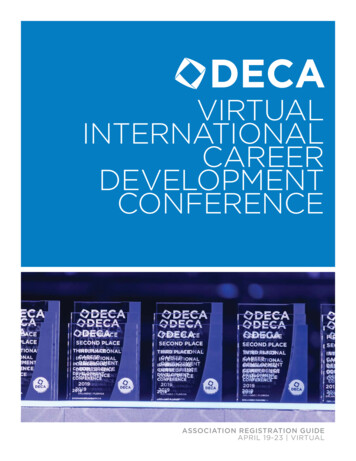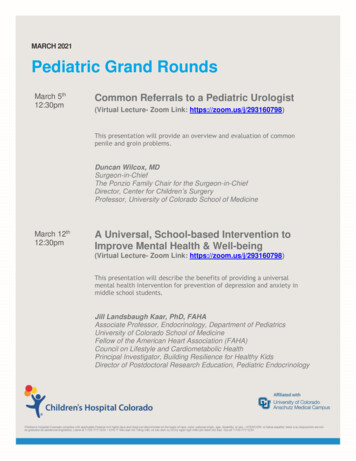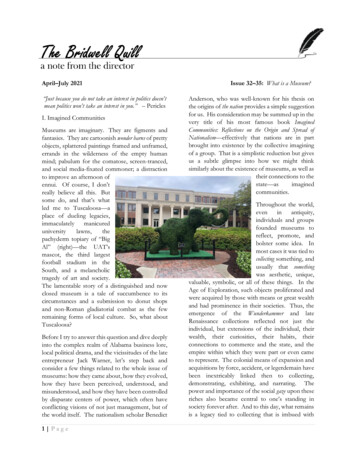
Transcription
April–July 2021“Just because you do not take an interest in politics doesn’tmean politics won’t take an interest in you.” – PericlesI. Imagined CommunitiesMuseums are imaginary. They are figments andfantasies. They are cartoonish wonder barns of prettyobjects, splattered paintings framed and unframed,errands in the wilderness of the empty humanmind; pabulum for the comatose, screen-tranced,and social media-fixated commoner; a distractionto improve an afternoon ofennui. Of course, I don’treally believe all this. Butsome do, and that’s whatled me to Tuscaloosa—aplace of dueling legacies,immaculately manicureduniversitylawns,thepachyderm topiary of “BigAl” (right)—the UAT’smascot, the third largestfootball stadium in theSouth, and a melancholictragedy of art and society.The lamentable story of a distinguished and nowclosed museum is a tale of succumbence to itscircumstances and a submission to donut shopsand non-Roman gladiatorial combat as the fewremaining forms of local culture. So, what aboutTuscaloosa?Before I try to answer this question and dive deeplyinto the complex realm of Alabama business lore,local political drama, and the vicissitudes of the lateentrepreneur Jack Warner, let’s step back andconsider a few things related to the whole issue ofmuseums: how they came about, how they evolved,how they have been perceived, understood, andmisunderstood, and how they have been controlledby disparate centers of power, which often haveconflicting visions of not just management, but ofthe world itself. The nationalism scholar Benedict1 PageIssue 32–35: What is a Museum?Anderson, who was well-known for his thesis onthe origins of the nation provides a simple suggestionfor us. His consideration may be summed up in thevery title of his most famous book ImaginedCommunities: Reflections on the Origin and Spread ofNationalism—effectively that nations are in partbrought into existence by the collective imaginingof a group. That is a simplistic reduction but givesus a subtle glimpse into how we might thinksimilarly about the existence of museums, as well astheir connections to thestate—asimaginedcommunities.Throughout the world,even in antiquity,individuals and groupsfounded museums toreflect, promote, andbolster some idea. Inmost cases it was tied tocollecting something, andusually that somethingwas aesthetic, unique,valuable, symbolic, or all of these things. In theAge of Exploration, such objects proliferated andwere acquired by those with means or great wealthand had prominence in their societies. Thus, theemergence of the Wunderkammer and lateRenaissance collections reflected not just theindividual, but extensions of the individual, theirwealth, their curiosities, their habits, theirconnections to commerce and the state, and theempire within which they were part or even cameto represent. The colonial means of expansion andacquisitions by force, accident, or legerdemain havebeen inextricably linked then to collecting,demonstrating, exhibiting, and narrating. Thepower and importance of the social gaze upon theseriches also became central to one’s standing insociety forever after. And to this day, what remainsis a legacy tied to collecting that is imbued with
www.smu.edu/bridwellpower politics, gradations of representation, andquestions of fairness. The museum has beenimagined and willed into existence by these many forcesand frames.It is no surprise then that the word museum itself hasa fairly, though not exclusively, uniform definitionwith a few particular exceptions. Among the onlyEuropean languages where “museum” is derivedfrom another root that sounds nothing like“museum” are Icelandic, Welsh, and ScottishGaelic. Safn in Icelandiccomes from “Old Norsesafna, a by-form of samna”(to collect, assemble), fromProto-Germanic*samnōną (to gather,collect).”In ScottishGaelic taigh-tasgaidh is theword used and can bebroken into “house (of)investment” or “hoardhouse.” Even in an IndoEuropean language likeHindi, the root (saṅgrah)of the word for museum (saṅgrahālay) means“collecting, compiling,” thus making the term mean“house of collecting.” Curiously, the commonChinese word (bówùguǎn) can be translated as“natural history pavilion.” And within Arabicspeaking cultures, the word for museum (mutḥaf)has as its root the word (tuḥfa), which can betranslated as “gift, masterpiece, artwork, or rarity,”indicating a particular sense of meaning and value.Every few years the International Council ofMuseums (ICOM) has sought to revise theirdefinition of museum, in order to keep up with thechanging world and our evolving socialperceptions. What each of these new definitionsexpresses is less about museums and more aboutindividuals in decision making positions, powerbrokers, and the socio-political landscape of a givenmoment. This was most apparent in the latestround of rewrites by the ICOM, which by mostaccounts began as a hopeful revision of thedefinition of museum and ended up as an unwieldystatement that enflamed factions and by someaccounts cost the ICOM president her job.2 PageThe ICOM was founded in 1946 and has a longhistory of these regular discussions to reevaluatedefinitions, though over the years these parametersbecame sprawling, clunky, and so expansive that aterm like museum itself could simply come to meanthe entire world. Suffering from postmodernity, weare situated in that position where we know it whenwe see it but can’t actually properly define anything becauseno definition is adequate. Yet, by looking at thesevarious definitions over time, we may be betterequipped to articulateboth the sophisticatedvisions of museums asideas and entities andhave a view of howsocietiesthemselveshave changed in thosethree quarters of acentury. Some of themostinterestingexamplesarethechanges made in theearly 1960s, whichreflectagreaterawarenessoftheenvironment and planet, when botanical gardens(above, Fort Worth Botanic Garden) and naturepreserves were included as museums. It was a timewhen thinkers like Marjorie Stoneman Douglas,Rachel Carson, and Roderick Nash wroteeloquently about nature and the burgeoningenvironmental movements; the 1970s, whenscience centers and planetaria were added to thedefinitions, just as the Space Age was in full swing;or the ballooning and nearly all-inclusivedefinitions of the 1990s and early 2000s, whichreflected the growth of major academic disciplinesand subfields that then expanded the definition ofmuseum to include regions, intangible heritageresources like biological organisms, and “digitalcreative activity;” and finally 2019, when issuesaddressing traditional power and moralresponsibility of global equity became centraldiscussion points in defining museums as society’smoral compasses. This most recent period has beenmarked by emphases on socio-economic inequities,injustices, and systemic harms suffered by peoples
www.smu.edu/bridwellon a global scale, which have led to someinstitutional self-reflections and adjustments.actions shall come, especially when it means howwe steward and shepherd the balances of fairness.My own approach to evaluating our question is tolook at this philosophically and in particular,ontologically—because the question what is amuseum? is an inquiry not into what is actually beingincluded in these evolving definitions, per se, butmore how and why it is being included. Yes, thecontents, presentations, and narratives of museumswill always be changing, but the one real constantis that they change—and the reason they change isbecause we change as people and societies. Ifrankly don’t worry too much about any of thesedefinitions, because they are extraneous indetails—details that will always be fought over.Some details will be at the center of discussions anddebates, some will be placed aboveothers, and at the end of anotherround of negotiations, what iswritten and publicized is thenewest demonstrable reflection ofboardmembers,executivedirectors, presidents, and curatorsseeking to broker power amongeach other and the society in whichthey want to make their mark. Andwhether we consider the Metropolitan, theEverglades, the San Diego Zoo, William Faulkner’sgrave (right), and a collection of Non-FungibleTokens (NFTs) all as museums is of little concern,because there will no doubt be a fight over whetherthey can each be designated as equal assetcategories of description.Narratives around historical discourses shall runand rage forever, but what is singularly importantin every generation is the recognition that museumsare both physical entities and ideas that requireconstant attention.Issues of representation,negotiations and struggles of power andpowerlessness, fundraising and allocations offinancial resources, and politics will always coursethrough the exhibitional veins of an institution. In thecore of all this, of these microcosms, I would argue,is the constant negotiation over identity,recognition, and remembrance. And the idea ofnegotiation itself is rooted in the Latin literallymeaning “not easy” or “lacking leisure,” because—and let us be frank: dealing withpeople is not easy! But that’s lifeitself. Negotiation, ultimately,is about dealing with balance,equity, and fairness.What really matters is that this is a process ofreflecting society. In so many ways, a museum issociety, a museum is people, a museum is us, nomatter how we try to re-define it. Because it is ourown human mirror—we reflect it and it reflects us,in a constant dialectic. Through the preservation,cultivation, exhibition, public face, and marketednarrative of institutions, we display thesereflections.In this way we negotiate ourassumptions about time, about the past, present,and future. And these assumptions about time aredirectly relevant to how we educate youth, becauseit is in children, adolescents, and young adults fromwhom the future critics and judges of our own3 PageAs a parent, I see thedistillation of global affairs inthe very raw and real powernegotiations that expressthemselves in my owndaughters’ struggles growing up with one anotherand in society where fairness is always the keyword—it’s not fair “this one got such an outfit” or“that one got some play date” or “another got icecream and ‘I didn’t.’” Similarly, in the media bazaarwe hear the echoes of progressive anti-billionairemantras, wealth taxes, expanded social services,balanced by counter claims of freedom and selfreliance. We also hear about fairness in theworkplace with pronouncements around sharedoffice spaces, equal pay, and workloads. Fromgovernmentstoemployerstoindividual relationships (whose turn is it to do thedishes?), nearly all forms of negotiation andconcern come down to a matter of perceivingfairness. As for museums, the issue of fairnessentails questions about the what, how, why,and when of representation, custodianship,stewardship, and memory. All of these arecrucially important to both the relevance andfuture sustainability of institutions however theymay be defined.
www.smu.edu/bridwellA recent example of this in Bridwell’s collections isthat of the Egyptian mummy from the A.V. LaneCollection, long on exhibit at the Dallas Museumof Art (DMA). The collection itself (examplesbelow) is older than Bridwell and was assembled byDr. Alvin Valentine Lane (1860-1938), who gavethe artifacts to SMU between 1917 and 1926, afterwhich the university established and opened as theLane Museum. Now a century later, it is no longera museum as such and the Egyptological contentsare mostly on display at the DMA. The currentdiscussions for Bridwell and SMU Art Historyfaculty have been around representation, curation,and display of the mummy itself. In recent years, acommon deliberation has concerned the ethicalpractices around displaying human remains,especially of non-Western persons in European orAmerican institutions—the presumption being thatcolonial or postcolonialpowers should notcontrol the narratives orbodies of other people(cf. the decolonizationmovement). In the caseof the Bridwell mummy,the DMA has the workon display with themummy’s feet exposedfor patron viewing. Atthe very time we had been having discussions aboutthe implications of this, I happened to be in theDMA and ran into a North African couple fromLibya, whom I then spoke to about this very issue.They spoke favorably of the exhibit and showingthe body and its feet. Yet, even this does not4 Pageprovide the adequate roadmap for how to navigatethe difficult terrain of representation, culturalsensitivity, and displays rooted in postcoloniallegacies. Even if those tourists have more of aphysical and even perhaps genetic connection tothe chthonic identity of that mummy than anyNorth American curator, they are but one voice;and there may be far more voices who woulddisagree with their positions.As we come to recognize museums as reflectionsof us and society, the question becomes “which us?”and “which society?” And who is really tellingwhich story and from what angle? That is what isimperative to how any museum or institution mustwork, or else we are liable to face far morechallenges ahead. The expansive spectrum ofdormant to vibrant museums will all be under thismicroscope, as we look to discern and evaluatenarratives into the 21st century (below left: a quietRock School Museum, Mineral Wells, TX; belowright: a bustling Mint Museum, Charlotte, NC).II. A Common Good?With this in mind, another necessary point to beaware of is the existence of markedly dichotomousvisions among different stakeholders, which seemoften, though not always, to divide roughly alongpolitical lines. That vision is one which reflectshow we come to understand ourselves, our spaces,and the integrity of defining ourselves in those veryspaces. Simply put, there are what I would call thesentimentalists and the futurists. This discernablefissure plays out in many unique ways but can beboiled down to those who look backward in historywith admiration, respect, honor, and pride (thesentimentalists), in contrast to those who look at thepast with suspicion,error, and contempt(the futurists) andfind the outlay oftoday’s problemsrooted in the faultof our collectiveancestors. For this latter group, the future is whatlies ahead and must be of most concern, while forthe former, the future is uncertain, problematic,and corrupting a past of glory with disrespect and
www.smu.edu/bridwellan anything goes attitude.Readers mayimmediately make the connection to the debatesaround statues and monuments. It is somewhatdifficult to articulate these differences andcontrasting visions, because most attempts seem toflounder in accusatory lambastes or devolve into acacophony that alienates us all intocompartmentalized pods of isolation and selfcenteredness. For the most part, our own visionsof the world, how we self-identify as eithersentimentalist or futurist will determine how weread a statue, envision a specialcollections library, or interpret amuseum: that they must bepreserved lest we forget any part ofthe past or that they need to bedemolishedactuallyandmetaphorically and rebuilt in orderto alleviate the structural andinherent sins of our world andancestors—indeed,soundingsurprisingly Calvinistic in itshamartiological purging!Theempathic connections to stone,paper, and image as conveyers ofhistory clash with the sympathiesand righteous declarations forjustice in the form of fairness—because everyone will define what is fair in theirown way, never agreeing on much of anything.And as much as we may presume all people are fora common good, it’s either too diffuse to determinewhat that common good is or we no longer believethere actually is a common good—like theconfounding management of COVID-19 and thepolitical fallout and cacophony over maskmandates and vaccine rollouts. (Above: the IllinoisMonument at Vicksburg National Military Park—acentury old vision of a common good throughmemorializing in stone).The noted economist Mancur Olson, Jr. onceposited in his 1965 book The Logic of Collective Action:Public Goods and the Theory of Groups that despite theshared benefits of the common good, ourindividual interests and demands for self-centereddesires will most often undermine and potentiallynegate that common good. Our myopias will lead5 Pageus and our solipsism will doom us, no matter whatside of this we are on. The paradox of democracyis that it is meant to represent the common goodso that the majority does not exploit the few, but inreality, according to Olson, the opposite is just aseasy to occur, where the majority is exploited andthe common good is not achieved.This is where the museum or cultural institution ascommon good comes into focus. Some estimates havethe United States government (local to federal)spending about 1.39B (2019) on the arts, whileGermany spent close to 12B inthe same period—nearly tentimes as much. Thus, within ourAmericancontext,ourunderstanding of common goodneeds to face the real facts aboutsustainability, maintenance, andacquisitions—and the moneyquestion is the question, perhapseven more than our principalinquiry: what is a museum? Thecommon good idea per capitadoes not translate highly in theartsforgovernmentcontributions, but instead echoesour country’s financial system ofcapital rewards—we spendaround 4.19 a person per year on the arts. Incontrast, Americans gave over 410B in donationsto various charities, including nearly 21B to “arts,culture, and humanities”—or roughly 63 a person.The uneasy tango of cultural institutions and theirfunding is central to the entire idea of a museum.Anyone who goes into museum work must beinducted into the fine arts of what has been calledthe Charity-Industrial Complex. Many museums donot have the deep pockets for purchasing worksthat are now prohibitively expensive and areacquired by a select few (e.g. Salvator Mundi that soldfor 450M in 2017 to the Saudi Crown Prince).The Metropolitan Museum of Art’s FinancialReport that same year had its total operatingexpenses at 305M—of which 232.2M came fromphilanthropy, dues, and the U.S. government.While there is a notion of a common good, it is tied tothe antique tradition of donors. Even as the word
www.smu.edu/bridwelldonor itself comes from the Latin root meaning togive, it is a word embodied by its relationship toother things, which have implicit and tacitunderstandings. You cannot give something unlessthere is a recipient of that action. And while manysuch gifts come from the love and kindnessresiding in the wellsprings of a person’s heart, thereare always a variety of reasons—even for theanonymous donor—why people give. Gratitude,appreciation, recognition, distinction, tax breaks,and a common good. But to give on any level is anexercise in power and where there is power therewill be questions of balance, equity, and fairnesssoon to follow. This is where the role of themuseum becomes a space of negotiation, but also alesson in ethics, because there are extents to whichan institution may go to accommodate the wishesof those who wield measures of control; and thereare extents at which the institution’s own expertsand leadership must assume responsibility anddemonstrate best practices that do not compromisethe institution’s integrity and ethical standards.The role of donor is justone aspect of money andfinance, though, becausethose who oversee the daily,monthly, quarterly, andyearly fiscal needs of aninstitution will always lookat the bottom line, but onlysometimes consider acommon good.If aninstitution is losing money,a finance committee andCFO will force cuts, whichare often undesirable in the eyes of the staff, public,or patrons. And sometimes, the salves to moneyproblems are popularizing ideas that are fringe tothe customary arts or traditional museums—as inthe case of the Indianapolis Museum of Art’scontroversial conversion to Newfields and all of itsglittering trappings, multi-age activities, andinteractive spaces; or the Columbus (Ohio)Museum of Art’s Lego exhibition (above).The idea of sustainability and survival go hand-inhand with relevance, because if we continue tooperate in a fashion that is no longer relevant, or is6 Pagenot adaptable, or does not keep pace with currenttrends and needs, our institutions will sufferincalculable losses, the battle lines will be drawn,and the doomsayers will demolish thesemuseums—think what could have happened to theDetroit Institute of Arts, after an EmergencyManager was installed in 2013, and it was suggestedthat the city auction off its world-class collections.Cultural heritage and capital often fall victim to therealities of debt and financial woes, especially whencreative solutions are not thought of quickly. Thisis another reason why such institutions need tohave solid and demonstrable arguments to securetheir futures and legacies.The idea of a common good may be elusive, but weknow that most people like to think that theircommunities have something to offer in the way ofarts and culture—even if that means sports. Withinthe walls of museums, battles continue about theacquisition of collections, preservation of objects,delegation of responsibilities, and curation ofmaterials. Every place is unique and has its ownstructural and institutionalchallenges, but these arebest thought of asopportunities for growthand development.Ashuman beings, we all haveour limits and these areexercised through ourwork and adaptability.Recognizing value in eachof our institutions comeswith both pride andsarcasm, because ourhuman nature is not simply to accept, but tonegotiate what we think is right, and this expressesitself in a spectrum of emotions and criticisms.Even among my suggested categories of thesentimentalists and futurists, there are equalopportunitypronouncementsaboutourinstitutions from “we need to preserve everything!”to “throw away all this old crap!” The commongood, then, has its own limits, because we hit ourlimits around what can be preserved,acknowledged, recognized, and seen as important.The next frontier then is value itself—our approach
www.smu.edu/bridwellto and understanding of what constitutes value,what has value, and what does not. This is thechallenge of axiology—or the study of value. Andas human beings, we assign gradations of value toeverything, which is, effectively, both the problemand solution.III. Axiology: Being, Time, and NothingnessOne of the most notorious works thatdemonstrates foundational differences in values andis specifically directed at museums, culturalinstitutions, and libraries is Nicholson Baker’scontroversial and vituperative work Double Fold:Libraries and the Assault on Paper published in 2001by Random House. In short, Baker places value onthe physical objects in our world that comprise ourcollective documented histories, and criticizes thelibrary profession, among others, for destroyingthis physical heritage in exchange for non-physicalsurrogates (microforms, films, and later digitalreplicas). Whether or not you buy what he says, hisarguments are based in avaluationofthephysical, temporal, andmeaningful objects thatpopulate all portions ofour lives and ourinstitutions.Onthemostphilosophical level thestruggle here is theperpetualtensionbetween ourselves andtime—but also, toconflate Heidegger andSartre, the very realpotential of negation in our lives and a futureontological nothingness. Even if not a singlelibrarian, or curator, or museum official thinks inthese terms, there is something very real about howwe view ourselves in relationship to the objects ofour workplaces or to objects that may comportmeanings in our world. Baker believed there wasin fact inherent, intrinsic, and important value inevery single historical object, while his adversariesand detractors in cultural institutions, whom hepresumed should have been protecting all physical7 Pageobjects like helpless newborns, were tossing thosenewborns into dumpsters and only keeping theirtraces, their content, their technologized shadows,if that at all. The extreme opposite case might beseen in the extraordinary work done by DavidKarpeles and the extensive network of hisnamesake Manuscript Library Museums in over adozen cities. Karpeles alone has amassed theworld’s largest private manuscript collection withmore than a million written items and hasdemonstrated in one man the distinction betweenindependent, autocephalous museums and themajority dominated by communities, boards, anddonors. With Karpeles and his museums, just aswith local or national museums, we see that anunderstanding of values is the focal point. Andsomeone like Nicholson Baker demonstrates thatthese values are disparate, contested, and fractious.The conflicting values in these cases are very realand happen in most institutions. Libraries stilldiscard books, museums and historical societiesstill sell, auction, orgive away materialsand artifacts if theyneed money, haveduplicates, or seek todevelopdonorrelations. And in anincreasinglydigitalworld with avatarsand surrogate optionsthat make physicalspecimens of paper,ink, wood, metal, orceramics look betteronline, we have anuphill battle to fight.Furthermore, thecomplexities of a pandemic and technological easehave moved patron behaviors toward self-directed,on-demand, any-time options for viewing theircultural spaces or institutions. But this should notbe the death knell of museums, instead it should bethe opportunity for adaptation, reform, and greaterrelevance. The focus must be on value itself andwhat that means to constituent groups.Having traveled all over the world and visitedscores, if not hundreds, of museums in my life, I
www.smu.edu/bridwellhave often taken notes and observed the intricaciesof special exhibits, patron interaction layouts, spacedesigns, and the objects on display themselves.Art museums are often myfavorite, because of howthey represent a wide varietyof human expressions in themost aesthetic and variedways. I am moved by colorsand compositions and thevisual encounter similar tothe way that certain musicaffects me. I usually comeaway with a profound senseof joy and inspiration. I alsovery much enjoy the distinct and peculiar museumswhich reflect the particular sensibilities of theircreators—those local museums, private museums,pet-project museums, roadside homes or gardensturned into museums like the Hole-In-The-RockHome on Highway 191 near Moab, Utah; theChandorGardensinWeatherford, Texas (p. 7);the Platen Press Museumin Zion, Illinois; theMarlene Yu Museum (p. 9)and the Water WorksMuseum and McNeil StreetPumping Station, both inShreveport,Louisiana(above and below); eventhe exhibit of moonshine memoirist “Popcorn”Sutton at Binion’s Roadhouse and Saloon inHendersonville, NC (left) is somekind of micro-museum. Each ofthese possesses an essence of theindividuals or communities whocreated them, their ideologies, theirspirit and reflection of a particularage, which may be anything fromelegiac and quirky to profound.There are many other distinct andunusualinstitutionsworthmentioning here: the City Museumin St. Louis; the Mary Kay Museumin Dallas; the Museum of Bad Artin Somerville, MA; the Museum of8 PageNothing and No Show Museum displaying“invisible art works” in Zurich; the Johnny CashMuseum in Nashville (below right); the Dog CollarMuseum in Kent, England; theBata Shoe Museum in Toronto;the Museum of Toilets in NewDelhi, India; and perhaps themostunorthodox:theIcelandicPhallologicalMuseum in Reykjavik. VariousFlightandAeronauticsmuseums (like the ChenaultMuseum in Monroe, LA),presidentiallibrariesandmuseums (Andrew Jackson’sHermitage, p. 10), and natural history museums arealso among some remarkable places to visit.In all of these places, the sense of value is temperedwith our relationship to and with time. Eachmuseum spaceand its contentsafford us theopportunity torelate to thepast in the waythatitisimagined andpreserved, and in some cases restored, by itsinterlocutors and curators. In each space, thefounders, oversight boards, staff, and localcommunities put value on the contents of theirmuseums, reflecting their own identities in relationto their own understanding of the past and howthey want to preserve that for thefuture.The question of value must also beasked not just of the museum’sleadership, but of those who come.We assume that museums aresomething, mean something, and conveysomething. But those assumptionsare different for every person, everyvisitor.The encounter andinteraction of the visitor is one ofgreat importance, because without anaudience, per se, what is a museum?If we are to recognize museums as
www.smu.edu/bridwellreflections of ourselves and our societies, weactually need society to be present, a willing partner inthe experiment and enterprise of museum making.So, what do we actually get out of the museumexperience? And what might that mean in thecontext of all kinds of institutions?Entering museums, walking through museums,sensing the full holistic and sensory experienceviscerally in museums, and then leavingmuseums—the feelings and thoughts that lingeronce you’ve left that museum—these are all part ofthe entire experience we need to reflect on. Whatdo we get out of seeing some old piece of fabricthat belonged to a famous person in a museum, oran object that existed in some location at someimportant date? Do we come away with some newsense of understanding, or something that changesour perceptions, opinions, or even ourselves ashuman beings? Or does nothing happen? Do wepass by objects andexhibits with blaséattitudes to expelthe time, boredactors looking foreyecandy?Presumably,weseek always to learn,to grow, to evolve, to become better human beings.The Carter Presidential Center in Atlanta, GA hasone of the most promising and humane missions ofany museum I have come across, a reflection of theformer president himself—the key line being: [theCenter] is guided by a fundamental commitment to humanrights and the alleviation of human suffering. Shouldn’tthat be all missions in our world—to value humanlife and alleviate
negotiations that express themselves in my own daughters' struggles growing up with one another and in society where fairness is always the key word—it's not fair "this one got such an outfit" or "that one got some play date" or "another got ice cream and 'I didn't.'" Similarly, in the media bazaar
